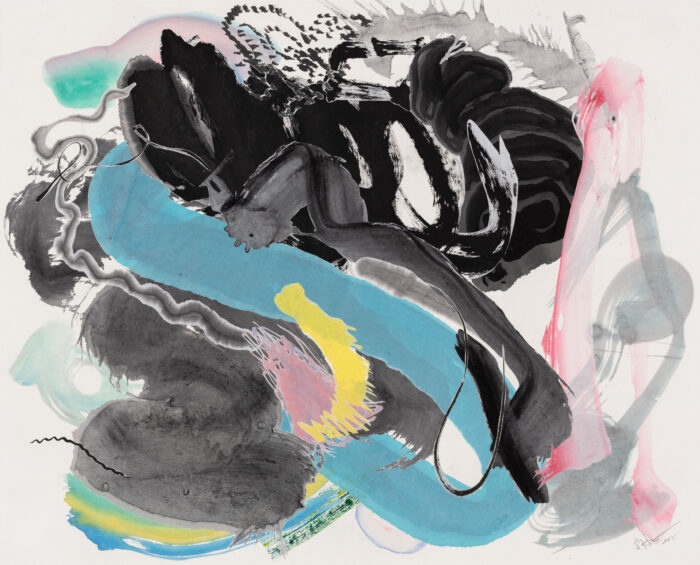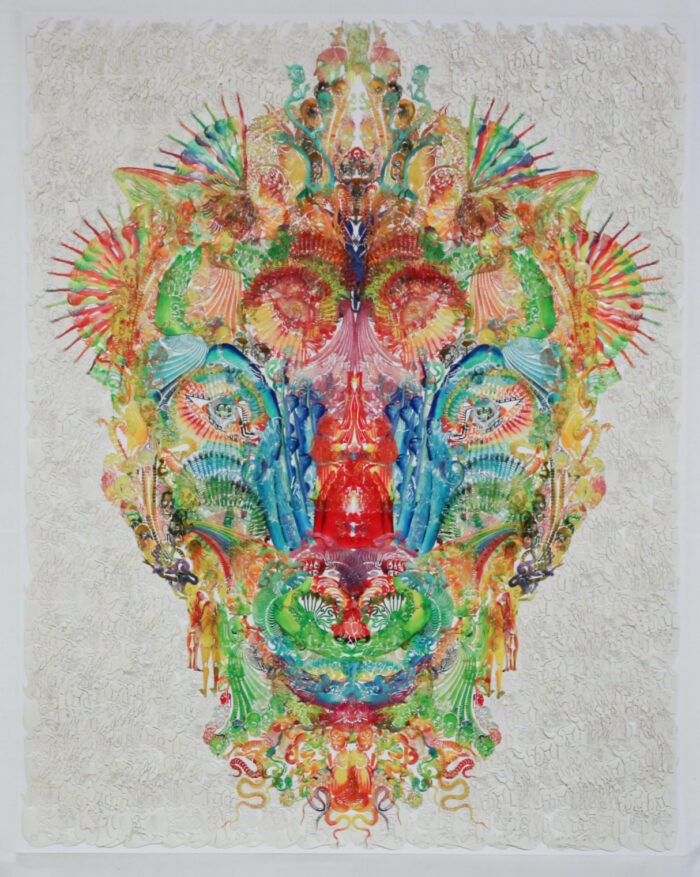
Born in 1980, Wu Jian’an has been an associate professor of experimental art
at the Central Academy of Fine Arts in Beijing. While in graduate school
there, Wu studied paper-cutting techniques, eventually devising an
innovatory process, in which the complicated cut pieces of paper would be
placed on a single monochromatic sheet. These sheets would be layered
on top of one another until the work attained the form of low relief. The
themes of such work involved Chinese mythology. But 500 Strokes, the
show’s title, offers a different kind of art. For this body of work, Wu invited
participants to choose a particular kind of brush from his collection, as well
as the density and color of the ink used; the person would then create a
single brushstroke, without referencing either a recognizable image or
calligraphic stroke. Strokes by many participants in Wu’s studio game are
then collaged onto a larger piece of paper, in a way that is so subtle as to
appear seamless, without layering.

The works themselves reference modernist and contemporary painters
from the West, including such artists as Mark Tobey and Brice Marden. As
for the strokes themselves, they may be either “good” or “bad” according to
the Chinese view, but their placement in a single composition allows Wu to
work with a range of effects, which to someone living in New York City,
looks very much like a new version of abstract expressionism. 500
Brushstrokes #73 (all the works in the show are dated from 2021) consist
of broad, black curving brushstrokes on the topmost layer, underneath
which we see a large, bulbous black form. Underneath this rounded shape
is a green band following the black form closely. On the right, there are
three masses of black, two of them made of thin, individual strokes allowing
the lightness of the paper to show through, and the other, purely black.
Beneath the last mass is a group of light pastel colors: pale peach, light
green, and a bit of pink. The piece exists at a good distance from traditional
Chinese painting, although its facture, in particular the attachment of the
brushstrokes in such a way that they feel like seamless passages of color
rather than collages, is deeply Chinese. Still, the painting strikes the viewer
as more Western than Asian.

Brushstrokes #78 is nearly a caricature of abstract expressionist form. With
a major, black curling stroke on the left, and an equally sinuous, curving
yellow-green stroke on the right, the composition announces its allegiance
to contemporary abstract art, created by more than a small number of
people. On the bottom left quadrant is a series of jade green/gray vertical
strokes, while on the bottom right, there is a series of thick strokes
gray/black in color. At the top, across the width of the composition, is a
complex array of mostly black, highly abstract effects, including an organic
mass of curvilinear black lines. The piece examples no evidence of
Chinese manufacture. It seems to tie in much more closely with Western
painting of the last fifty years.

The final piece, Shapeshifting Deity, is a Hand dyed and waxed paper-cut of astonishing
complexity. The head looks very much like that of a tiger’s, and the colors,
too numerous to mention, express themselves in a detailed fashion, filling
narrow shapes and forms. Hand-dyed papercuts detail a bright red nose,
eyes of animal-like intensity, and a series of bulbous, multi-colored masses
on the head, from which protrude thin spikes. Clearly representational,
despite they myriad small forms it consists of, the deity comes across as a
vehicle of ferocity, capable of changing form from one moment to the next.
As a paper cut, this piece dates back to earlier efforts by Jian’an. The show
throughout demonstrates remarkable skill and also an awareness not only
of earlier traditions but also of much newer art. Wu has produced a
compelling body of work, incorporating not only technical skills but also
conceptual advances, which make him a notable artist.


